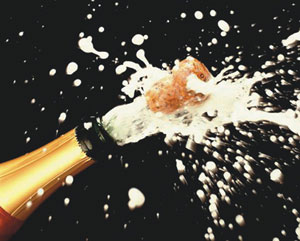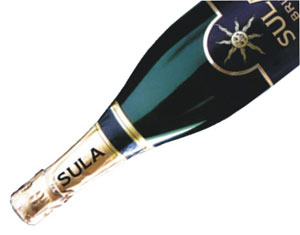| |
Uncorking the Good Times
A new breed of top quality local wines is weaning Indians away from hard liquor towards the healthier and more sensual pleasure of the grape
By Rakesh K Simha
 |
|
Time was when buying a bottle of good wine meant (tick one) a call to your neighbourhood bootlegger, a huge hole in your pocket, genuflecting before your contact at the embassy/consulate.
Times have changed.
Today, you can grab a bottle of superb Indian wine for under Rs 500 from Bandra or Khan Market. Your hosts at the Malabar Hill/Prithviraj Road party won't blanch if you land up with a bottle of Marquise de Pompadour or a Sula Chenin Blanc. Indeed, they may be impressed.
With India's "upper class"-10 million at last count-ridding itself of its Scotch fixation and
|
discovering the joy of grapes, the spirits are soaring in Sahyadari Valley, India's vine belt in the Deccan and our answer to California's Napa Valley.
After languishing for years in the back rows of liquor shops, and consumed by whisky and beer envy, a new breed of Indian wines is vexing wine snobs and fetching record sales. India's three main vintners, Champagne Indage Limited (CIL), Sula and Grover Vineyards, are busy filling up those racks in India's liquormart.
And with Asti Spumante being the flavour of the season in India's power centre, there's never been a better time for wine drinkers to uncork the bubbly.
Rajeev Samant, the managing director of Sula Wines, which claims to have eased past Grover to second spot in the Indian market, compares the transformation in the wine scene to what happened with beer. "Beer was not a major drink 10 years ago but today Kingfisher has made it cool to drink beer," he says. "We believe wine sales will take the same trajectory."
It isn't wishful thinking from Samant. Though the lager crowd and rum addicts will scarcely budge from their perch, one thing's clear-the educated Indian consumer is moving from "drink to get drunk" to acknowledging that wine is a health drink, a lifestyle drink.
Says Subhash Arora, the president of the Delhi Wine Club and one whose passion for wine is truly intoxicating, "Due to wider travel abroad, where wine is generally a lifestyle drink, these jet setters are developing a taste for wine."
|
Sure, the switch is slow and partial. The work-hard-party-harder culture implies that the young have to get sozzled-and fast-to let their hair down.
But as they grow older, people are getting more health conscious. Since wine is said to benefit the heart and increase longevity, many Indians are saying no to whisky and oui to wine.
Women are a major driver of sales. Not only do women join in with the men if wine is being consumed, they actually go out and buy the stuff. Archana Mushran., 36, a manager with a leading Chennai-based multinational company, agrees. "I only drank wine brought from duty-free shops, but last year a friend in Delhi introduced me to a Grover La Reserve and since then I haven't looked back,"
she says.
Clearly, it's a case of grapes turning sweet. Members
|
|

|
|
of
the champagne crowd won't roll their eyes if you mention Indian wine. Abhishek Khaitan, the chairman of Radico Khaitan, which imports premium labels like Gallo, says, "Indian wine is great value for money."
There is a new maturity not only among aficionados but among top restaurateurs and retailers as well. Few are shy of stocking the bubbly. Says the F&B manger at a top Mumbai hotel, "Today we sell several bottles of fine Indian wine at our restaurants."
Food and wine have superb synergy. With specialty restaurants opening at a fast pace, wine becomes a part of the dining out experience and people are willing to try wines with food.
Anticipating a sales boom, the retail trade is being refurbished too. Wine shops aren't what they used to be. In the Delhi State Civil Supplies Corporation's liquor outlet in Delhi's Khan Market, assistant manager P.N. Jamaiyar is pulling out all the stops to achieve targets. His staff can reel off the names of French wines, grape varieties and vintages, and advise you on the type of wine to take with different foods. It may leave you
speechless
|
 |
|
Jamaiyar says, "Earlier only foreigners visited our wine section; Indians would head straight for the whisky shelves and beer coolers. Now Indians, albeit hesitantly, enquire about wines."
Indians have to be educated about the excite-ment that wine has to offer because of its complexities in taste, aroma, acidity, tannins, after-taste and so on. In short, develop the consumer's palate for wine. As Arora says, "Wine is a lifestyle drink and its demystification is important for increasing consumption."
CIL, the pioneer in the wine business and Indias' No.1 winemaker, promoted wines in hotels by introducing it as a drink to be enjoyed with lunch. As the Indian consumer's resistance against wines as a "ladies drink" wore off, a variety of products were introduced, from white to red and sparkling to rosy.
The wine drinkers club in India is gaining critical mass. Last year, Sula produced 300,000 bottles of wine and in 2004-05 the company is set to notch up sales of
550,000 bottles.
|
Okay, now here's the bad news. Sticker shock is a big downer on sales: taxes comprise a major portion of MRP. For a bottle of wine that costs Rs 200 ex-winery, excise can be as high as Rs 200 while marketing, distribution and commission costs can add another Rs 150, jacking up the label price to Rs 550.
But price cuts can work magic. Recently, the MRP of a bottle of Sula Chenin Blanc, India's largest selling premium white wine, came down by Rs 100 after Maharashtra government slashed taxes, classifying wine as an agro-based product. Let's face it, even in premium products, Indians remain price sensitive.
At the end of the day, image is what counts, and keeps those cases moving. "Today, if you arrive at a penthouse party with a bottle of Indian whisky, it may turn out to be cardiac event for your guests. But that won't be the case if you land up with a Sula," crows Samant.
Samant can be excused that plug. Sahyadari Valley is now recognised as a quality grape-producing region by the Commission of the European Communities. And wines from that region are winning awards abroad and rave reviews at home.
There may be plenty of hiccups, but Indian wine
| |

|
is here to stay. Older players, who have so far neglected their wine divisions, are waking up to the new market. McDowell Winery at Baramati, Shaw Wallace Winery at Hyderabad (Ruby, Golconda) and the Goans will certainly put up a fight.
| Wine Type |
|
% of sales in India |
| White wine |
|
50 |
| Red wine |
|
30 |
| Port wine |
|
10 - 20 |
| Champagne |
|
10 - 15 |
|
|
Companies are bringing in wine masters and introducing better grapes from the West. Maharashtra and Karnataka are laying out the welcome mats for the wineries. Nashik Valley is
already becoming known for its white wines, especially Sauvignon
Blanc and Chenin Blanc. Himachal Pradesh is another area that
is showing |
promises.
|
Per Capita Wine Consumption |
| France |
Italy |
Spain |
UK |
India |
| 60 litres |
59 litres |
37 litres |
24 litres |
0.007 litres |
|
Major
Markets % |
| Mumbai |
Delhi |
Goa |
Bangalore |
| 39 |
23 |
9 |
9 |
As Arora says, "The manner in which these companies are pushing products, there is bound to be an exponential growth in wine drinking."
Hangover or not, we'll raise a toast to that.
|
|
|